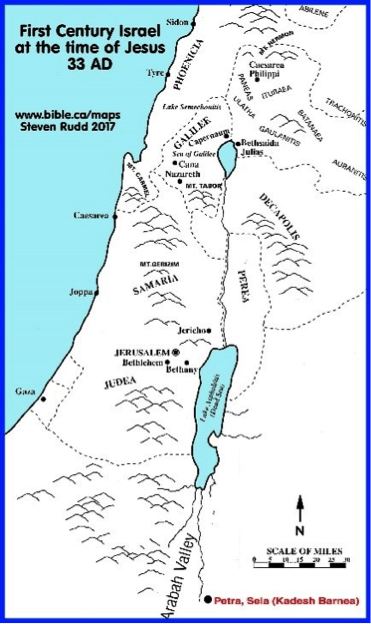The Parable of the Sower
13 That same day Jesus went out of the house and sat beside the sea. 2 Such great crowds gathered around him that he got into a boat and sat there, while the whole crowd stood on the beach. 3 And he told them many things in parables, saying: “Listen! A sower went out to sow. 4 And as he sowed, some seeds fell on the path, and the birds came and ate them up. 5 Other seeds fell on rocky ground, where they did not have much soil, and they sprang up quickly, since they had no depth of soil. 6 But when the sun rose, they were scorched; and since they had no root, they withered away. 7 Other seeds fell among thorns, and the thorns grew up and choked them. 8 Other seeds fell on good soil and brought forth grain, some a hundredfold, some sixty, some thirty. 9 Let anyone with ears listen!”
New Revised Standard Version Bible: Catholic Edition, copyright © 1989, 1993 the Division of Christian Education of the National Council of the Churches of Christ in the United States of America. Used by permission. All rights reserved.
What to do with this educator’s commentary
This commentary invites you as a teacher to engage with and interpret the passage. Allow the text to speak first. The commentary suggests that you ask yourself various questions that will aid your interpretation. They will help you answer for yourself the question in the last words of the text: ‘what does this mean?’
This educator’s commentary is not a ‘finished package’. It is for your engagement with the text. You then go on to plan how you enable your students to work with the text.
Both you and your students are the agents of interpretation. The ‘Worlds of the Text’ offer a structure, a conversation between the worlds of the author and the setting of the text; the world of the text; and the world of reader. In your personal reflection and in your teaching all three worlds should be integrated as they rely on each other.
In your teaching you are encouraged to ask your students to engage with the text in a dialogical way, to explore and interpret it, to share their own interpretation and to listen to that of others before they engage with the way the text might relate to a topic or unit of work being studied.
Structure of the commentary:
The world of the Matthew’s community
Text & textual features
Characters & setting
Ideas / phrases / concepts
Questions for the teacher
The world in front of the text
Questions for the teacher
Meaning for today / challenges
Church interpretations & usage
The World Behind the Text
See general introduction to Matthew.
The world of the text
Text & textual features
A Parable
The text is a parable, a simple story used to illustrate a moral or spiritual lesson that uses similes, metaphors or vivid imagery to tease the mind into working out what is being said. While the elemements – talking about fish and nets to fisheds and sees and sowings to farmers – mig have been familiar to the first audience, parables have someting bizarre or mysterious about them. In many cases this unfamiliar happening or strange concept would have been more affronting to the orginal audience than they are to us today.
Common features of parables include repetition, contrast, reversal of expectations, the frequent use of three characters or incidents, and a climax built around the last character in the series. This parable has a contrast (the smallness of the seed and the size of the shrub) and a reversal of expectations (that the shrub will support the nests of the birds of the air).
Parables often invite their audience to reflect on their behaviour by illustrating a moral or spiritual lesson. “Each reader will hear a distinct message and may find the same parable leaves multiple impressions over time… reducing parables to a single meaning destroys their aesthetic as well as ethical potential” (Levine, 2014, p 1).
Matthew 13
In the chapters prior to this, Matthew has focused on those how doubt Jesus and attack him. These stories serve to invite questions as to why people respond so differently to the invitation to be a part of God’s kingdom.
Matthew 13 contains eight parables and two explanations of parables; it is the third teaching discourse in the gospel of Matthew and is sometimes referred to as the Parabolic Discourse. The parables in the chapter are commonly called: The Parable of the Sower (Matt 13: 3-9), The Parable of the Weeds (Matt 13: 24-30), The Parable of the Mustard Seed (Matt 13:31-32), The Parable of the Leaven (Matt 13:33), The Parable of the Discovered Treasure (Matt 13: 44), The Parable of the Pearl (Matt 13:45-46), The Parable of the Dragnet (Matt 13:47-50), The Parable of the Scribe (Matt 13: 51-52).
The two explanations of the parables are for The Parable of the Sower Explained (Matt 13: 18-23) and Jesus Explains the Parable of the Weeds (Matt 13:36-43). It must be noted that, in their original telling, these parables would not have told with the explanation; these have been added at a later date.
In Matt 13: 10-17, the disciples ask Jesus why he teaches in parables. Jesus quotes Isaiah 6:9-10 suggesting that he speaks in parables as a consequence of the incomprehension of his audience. Jesus pities his audience who need to turn that he might heal them but are blessed in that their eyes and ears are experiencing things that were denied the prophets and other righteous people.
While Jesus is widely recognised as a prolific user of the parable, they were not uncommon in Judaism. Matthew’s audience, seeking confirmation of Jesus as the fulfilment of the promises made to Israel, would have recognised this form and it use to prompt thinking and thus to teach.
Jesus tells many stories in the form of a parable, including this one. Parables are simple stories used to illustrate a moral or spiritual lesson. “Each reader will hear a distinct message and may find the same parable leaves multiple impressions over time… reducing parables to a single meaning destroys their aesthetic as well as ethical potential” (Levine, 2014, p 1).
Parables generally begin ‘the kingdom of heaven is like..’, however, the parable of the sower breaks this trend, setting the entire scene for all the parables that will follow in the chapter, concluding with the final parable in this series of the fishing net (Matt 13:47-50).The parable of the sower is also featured in Mark (4:3-9).
Characters & setting
The story takes place at the Sea of Galilee which is the upper lake in the map below.

Jesus’ move into the boat is probably a practical one but also invites the reader to consider the ‘bigger’ story – Jesus moving away from the people of Israel as a whole and becoming more focussed on the disciples.
Typically, October and November was the time for planting with the early rain. Farmers would then weed and cover the crops (called ‘harrowing’). Many of the festivals of Israel were linked to the farming calendar as it was a pivotal part of life. For example, the Passover was celebrated at the beginning of the barley harvest and fifty days later, the festival of Pentecost celebrates the beginning of the wheat harvest. For the reader today, just scattering seed onto the ground does not seem like a well-managed farming practice. Many historians would suggest that in Palestinian farming practices, sowing preceded ploughing so it is reasonable to assume that the sower was coming back. Considerably more seed was used than what we would use today, about twice as much.
Ideas/phrases/concepts
Sower
What we would understand as a farmer
Hundredfold
In our setting of hundreds of hectares of farming land, a hundredfold might not seem much, but in the setting, it is an astonishing yield.
Let Anyone With Ears Listen
A clever play on words: the individual cob or stalk on which the individual kernels or grains are called ‘ears’. Other interpretations translate this as ‘let anyone who can hear listen’.
Questions for the teacher:
The world in front of the text
Questions for the teacher:
Please reflect on these questions before reading this section and then use the material below to enrich your responsiveness to the text.
Meaning for today/challenges
Parables are based on metaphors, comparing two things and finding meaning in the overall subject. This one invites us to think from multiple perspectives.
If the sower is Jesus (God) and the seeds God’s words (vision and action), then the parable speaks of spreading of the word of God. We, people, become the soil; at times not very receptive or momentarily receptive: hearing God’s word but then letting it die off or be choked out with competing interests.
At another level though, we could be the sower. Is Jesus telling his disciples that in God’s kingdom they must be him? From this perspective we are invited to think about what we say and do – what we sow.
Yet again, we could be the seed, thrown by God into circumstances of varying possibility. Facing defeat at times, finding fertile ground at other times. However you may interpret it, the parable contains lessons to be learned: do not be deterred; expect challenge; chose what to sow carefully; don’t stop planting! The parable of the sower is an invitation to hope.
Today the world is changing far more rapidly than Jesus’ could have ever imagined. We must find innovative and new solutions for the challenges of our times. Tradition is not enough, we must live with creativity (Pagola, 2012, p. 127). We live in a much more secular society than ever before and the traditional methods for sharing the stories of Jesus; evangelising, are less effective. This does not mean that what we sow does not have value but that the method of sharing must use the best biblical knowledge with imagination, creativity and boldness. This parable itself challenges us to move into new ways of living with God.
Church interpretation & usage
Unlike the parables in general, the Church does not use this text to make a particular point or emphasis.
Pope Francis, in preaching on this text in 2017 said, “Jesus invites us today to look inward: to give thanks for our good ground and to work on the ground not yet good” (Francis, 2017).
The parable is often interpreted and understood to make the point that in despite some failure opposition and indifference, Jesus’ message about the coming of the kingdom will be enormously successful. The time this occurs in may not be our own.
Liturgical Use
The text is the Sunday Gospel on the fifteenth Sunday in Year A. It is accompanied by Isaiah 55:10-11 and Romans 8:18-23. Broadly speaking, the themes of these scriptures are of hope.
